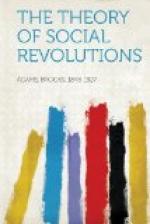On the morrow the great day had come. Saint-Just rose in the Convention to read a report to denounce Billaud, Collot, and Camot. Tallien would not let him be heard. Billaud followed him. Collot was in the chair. Robespierre mounted the tribune and tried to speak. It was not without reason that Therezia afterwards said, “This little hand had somewhat to do with overthrowing the guillotine,” for Tallien sprang on him, dagger in hand, and, grasping him by the throat, cast him from the tribune, exclaiming, “I have armed myself with a dagger to pierce his heart if the Convention dare not order his accusation.” Then rose a great shout from the Centre, “Down with the tyrant, arrest him, accuse him!” From the Centre, which until that day had always silently supported the Robespierrian Dictatorship. Robespierre for the last time tried to speak, but his voice failed him. “It’s Danton’s blood that chokes him; arrest him, arrest him!” they shouted from the Right. Robespierre dropped exhausted on a bench, then they seized him, and his brother, and Couthon, and Saint-Just, and ordered that the police should take them to prison.
But it was one thing for the Convention to seize Robespierre singly, and within its own hall; it was quite another for it to hold him and send him to the guillotine. The whole physical force of Paris was nominally with Robespierre. The Mayor, Fleuriot, closed the barriers, sounded the tocsin, and forbade any jailer to receive the prisoners; while Henriot, who had already been drinking, mounted a horse and galloped forth to rouse the city. Fleuriot caused Robespierre, Couthon, and Le Bas to be brought to the City Hall. A provisional government was completed. It only remained to disperse the Assembly. Henriot undertook a duty which looked easy. He seems to have collected about twenty guns, which he brought to the Tuileries and trained on the hall of the Convention. The deputies thought all was over. Collot-d’Herbois took the chair, which was directly in range, put on his hat, and calmly said, as Henriot gave the order to fire, “We can at least die at our post.” No volley came—the men had mutinied. Then the Convention declared Henriot beyond the protection of the law, and Henriot fled to the City Hall. The Convention chose Barras to command their armed force, but save a few police they had no force. The night was wearing away and Fleuriot had not been able to persuade Robespierre to take any decisive step. Robespierre was, indeed, only a pettifogging attorney. At length he consented to sign an appeal to arms. He had written two letters of his name—“Ro”—when a section of police under Barras reached the City Hall. They were but a handful, but the door was unguarded. They mounted the stairs and as Robespierre finished the “o”, one of these men, named Merda, fired on him, breaking his jaw. The stain of blood is still on the paper where Robespierre’s head fell. They shot Couthon in the leg, they threw




